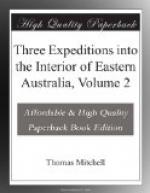bogs, I devoted the day to an extensive reconnaissance
of the country before us; my guide in this case being
the river Crawford which, flowing in deep ravines,
was likely to afford (so long as its general course
continued to be nearly parallel to our route) one
means at least of avoiding those soft swampy flats
which could not possibly impede us so long as the
side of such a ravine as that of the river was within
reach. I had the good fortune to find that the
range in general was firm under the hoof, and its direction
precisely such as I wished. Extensive swamps
occasionally appeared on my right; but I had on the
left the deep ravines of the Crawford, and I travelled
across the highest slopes of the ground. Having
thus found good sound turf for twelve miles in the
direction in which I wished to take the carriages,
I returned on descending from a trap range where the
rock consisted of granular felspar and hornblende
with crystals of glassy felspar. On this hill
the soil was exceedingly rich and the grass green
and luxuriant. I obtained thence a most useful
bearing on Mount Gambier, and saw also some heights
to the eastward beyond the Rifle range. The timber
grew to an enormous size on the ranges which I traversed
this day; it consisted chiefly of that species of
eucalyptus known as stringybark. Some of the
trees we measured were 13 feet and one as much as 14
1/2 feet in circumference, and 80 feet was no uncommon
height. The fallen timber was of such magnitude
as to present a new impediment to our progress for
we had not previously met with such an obstruction
on any journey.
CROSS THE CRAWFORD.
August 24.
The carriages were taken across the Crawford without
much delay considering its depth and the softness
of the banks. The carts sank at least five feet
in the water yet nothing was damaged for we had taken
care to pack the flour and other perishable articles
on the tops of the loads. We succeeded in crossing
the rivulets at the heads of several ravines by filling
up their channels with logs; and thus, after crossing
the last of these, and ascending the steep bank beyond
it, we encamped after a journey of seven miles.
The weather had been stormy on both days since I crossed
the Crawford, a circumstance very much against our
progress. Near this camp we found a new Correa,
resembling C. virens but having distinctly cordate
toothed leaves with less down on their underside and
a much shorter calyx.*
(Footnote. C. cordifolia, Lindley manuscripts;
stellato-tomentosa, foliis subsessilibus cordatis
ovatis denticulatis obtusis planis supra glabris,
corollis tubulosis cernuis, calyce truncato brevissimo.)
BOGGY CHARACTER OF ITS SOURCES.
August 25.




